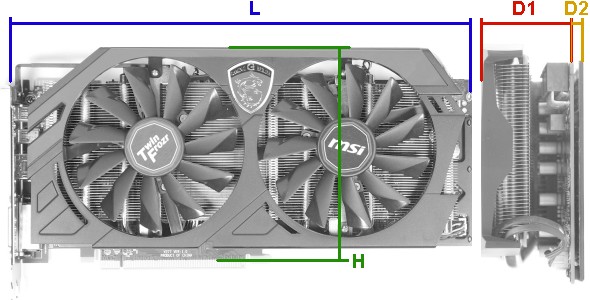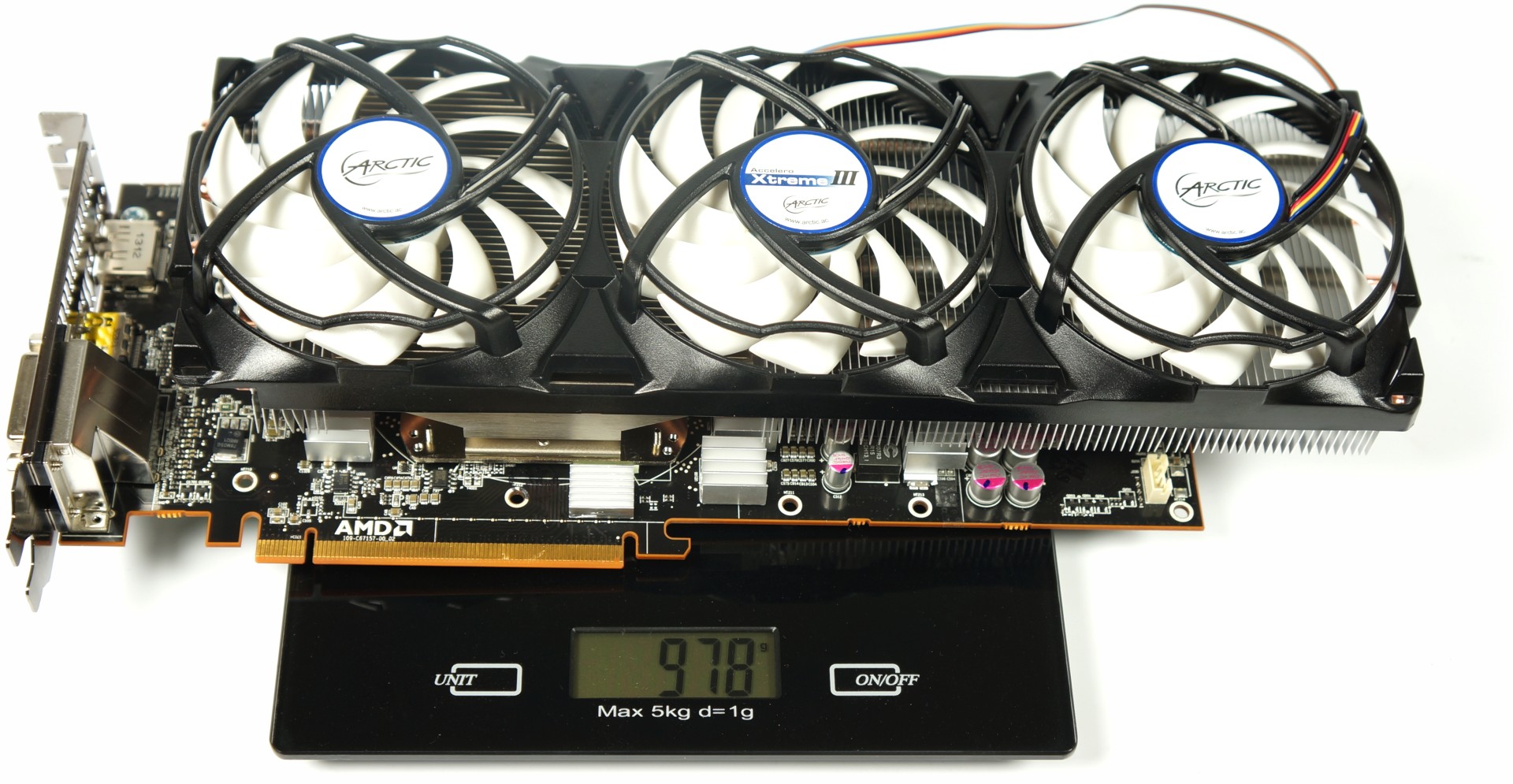Partner Cards: Two Radeon R9 290s And Five 290Xs, Updated
Dimensions And Weight
The dimensions reported here don't necessarily match what you've heard from each manufacturer's official technical specifications. Rather, we measure them by hand to assure they're correct. The image and chart below should help illustrate what each measurement actually means. Auxiliary PCI Express power connectors are not included; they have to be added depending on the power plug and cable design.
| Radeon R9 290 | Length (L) | Height (H) | Depth (D1) | Depth (D2) |
|---|---|---|---|---|
| Sapphire Tri-X OC R9 290 | 305 mm | 114 mm | 38 mm | 4 mm |
| Gigabyte GV-R929OC-4GD R9 290 Windforce OC | 282 mm | 123 mm | 38 mm | 4 mm |
| Radeon R9 290 Reference + Arctic Accelero Extreme III | 320 mm | 120 mm | 60 mm | 4 mm |
| Radeon R9 290X | Length (L) | Height (H) | Depth (D1) | Depth (D2) |
|---|---|---|---|---|
| Asus R9290X-DC2OC-4GD5 R9 290X DirectCU II OC | 288 mm | 142 mm | 38 mm | 4 mm |
| Sapphire Tri-X OC R9 290X | 305 mm | 114 mm | 38 mm | 4 mm |
| Gigabyte GV-R929XOC-4GD R9 290X Windforce OC | 282 mm | 123 mm | 38 mm | 4 mm |
| HIS R9 290X IceQ X² Turbo | 297 mm | 135 mm | 36 mm | 4 mm |
| MSI R9 290X Gaming 4G | 279 mm | 120 mm | 38 mm | 6 mm |
Graphics Card Weight
The weight of a card might be interesting if you're trying to figure out if any additional support is needed, or to calculate the amount of stress your motherboard might be under in a CrossFire-based setup.
| Radeon R9 290 | |
|---|---|
| Sapphire Tri-X OC R9 290 | 1022 g |
| Gigabyte GV-R929OC-4GD R9 290 Windforce OC | 1040 g |
| Radeon R9 290 Reference + Arctic Accelero Extreme III | 978 g |
| Radeon R9 290X | |
|---|---|
| Asus R9290X-DC2OC-4GD5 R9 290X DirectCU II OC | 1135 g |
| Sapphire Tri-X OC R9 290X | 1022 g |
| Gigabyte GV-R929XOC-4GD R9 290X Windforce OC | 1053 g |
| HIS R9 290X IceQ X² Turbo | 976 g |
| MSI R9 290X Gaming 4G | 1038 g |
Get Tom's Hardware's best news and in-depth reviews, straight to your inbox.
Current page: Dimensions And Weight
Prev Page Technical Specifications Next Page Gaming Power Consumption
Igor Wallossek wrote a wide variety of hardware articles for Tom's Hardware, with a strong focus on technical analysis and in-depth reviews. His contributions have spanned a broad spectrum of PC components, including GPUs, CPUs, workstations, and PC builds. His insightful articles provide readers with detailed knowledge to make informed decisions in the ever-evolving tech landscape
-
yannigr You can write as many articles as you want about 290/290X coolers. You can write as many excuses as you want. You can continue reminding us that there was/is a problem with Hawaii every 15 days for the whole 2014. That "victory dance" that "excitement" that you found(?) AMD cheating(?) back then, all that rage against AMD, can not be unwritten.Reply -
FormatC Replyall that rage against AMD
I would like to know this more precisely please... I can't found any rage in my articles, only a chip with a very high temperature density and a lot of unusable coolers because the engineers were not able to build a matching cooler for this cards. This high density will be a global problem for all next-gen chips too. Without a vapor chamber this won't work. -
outlw6669 Good job on the review Tom's German team and great work from AMD's partners!Reply
Coupled with other recent reviews, Sapphire's Tri-X OC series looks to be great cards, especially when you make a custom fan curve to further reduce idle and load noise.
I can not wait to see the 20nm updates, especially if AMD gets around to pulling a Titan with their reference coolers! -
FormatC I will add in the next days more cards like Gigabyte's R9 290 (without X), the MSI R9 290X and something other (secret) :)Reply -
rdc85 I think this card is made/means to be WC -ed..... 290 in Kraken looks promising.. (trying imagine how good if in full water block, good radiator)Reply -
roymustang The main problem with the 290 and 290X isn't the cooling, it's the fact that bitcoin and litecoin miners have driven the price of these cards up by $100-150; to the point where they are no longer a good deal at all.I was waiting for the custom cooled 290s to come out to upgrade my GTX 670 but now I may just wait for the next cards and maybe stick with nVidia.Reply -
Phillip Wager i want so badly the 290 to go back to 400 bucks cuz that is like my hard limit on a video card ive been waiting but i don't think i can wait much longer and i guess i'll just get a 770. i'm even willing to put up with the reference coolers bah.Reply -
patrick47018 "You can see this in the image below, where two of the heat pipes don't **tough** Hawaii at all, and two others make partial contact. " Spelling mistake, on topic I like the Sapphire Toxic's design and performance.Reply

